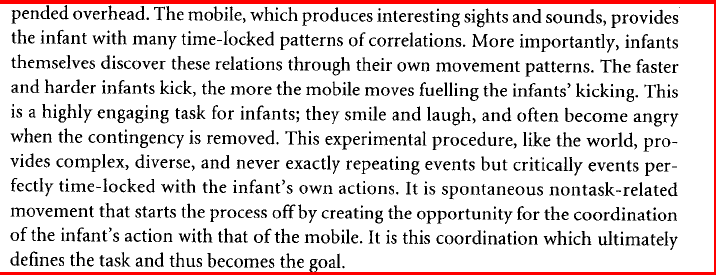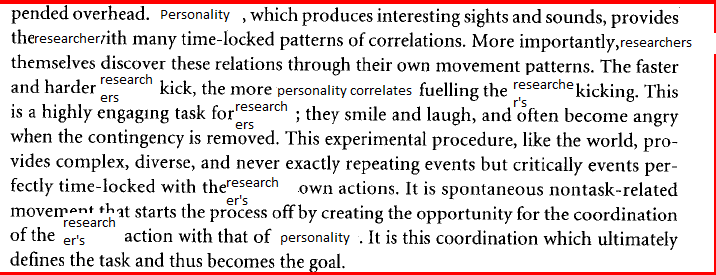As a system, there has to be a continuously reproducable heterogeneity of processes, for there to be an emergent level (a system) from it. The only difference between animate and non-animate things, is that animate things continue to produce stably reproducible homogenous levels (by heterogenous sub-processes). Non-animate objects can only create homogenous processes, more of the same, unless they increase into vast sizes (which means they are not unimportant because they have consequences for possible interactions in lower levels, like gravity being a prerequisite of biochemical organisms). When the interaction is reproduced over time however, the emergent level becomes less temporary. The emergent level needs to be reproduced homogenously over time, i.e. the consequences of a heterogenous system needs to be homogenous. Constraints, and laws, ensure this to be the case (stochasticity under laws). For example, gravity is stable enough through both space and time on earth to sustain life to develop further. Thus, a system like a human being needs to be able to reproduce work to survive, but perceiving a human (the system) as a unit, its constituent parts need to be heterogenous. This entails that otherwise no “internal” (to the system) difference can be created, nothing to drive the system.
When it comes to humans, I believe “emotions” drive our system. They are field potentials contained through (not in) our body. The experience of emotions, their phenomenology, is different to what I mean by “emotions” in this article (make no mistake that these thoughts are founded on direct perception, although this doesn’t necessarily has a bearing on “emotions”, we are still far away to hypothesise differently though). Let’s assume that our experience of the world simply is the continuous flow of collective (all senses) perception of the world, we perceive the world directly (in the philosophical sense) but propagation through our body (whatever, after we understand the specificity of direct perception, may end up being “in” us) takes time. Thus, and also traditionally, our experience of “emotions”, can be a part of the perceptual online flow and experienced as emotions.
“Emotions” are the driving forces of any biochemical thing (or organisms). “Emotions” are the consequence of Direct Perception and Acting in the world (as well as the history of previous DP and A). They are the internal force acting on the system to create difference –and in the continued propagation, creates an autocatakinetic system around the initial force. This means that forces can have graded impact on us, and if weak and not reproduced over time, simply abates. If reproduced, resulting in build-up of impact, or if the force is strong to begin with, it then forces an “internal” difference, creating an autocatakinetic system around it and becoming the internal force acting continuingly back onto the system. These “internal” potentials can be abated by producing work (herein is defined as body movement [muscle movement by limbs, body and/or face {including the vocal tract}] and biochemical compounds [saliva, sweat, excrement, etc]). One point is that this means I believe emotions act as the threshold for human systems to self-organise into different behaviours. Another point is that our body is a less temporary process (a structure) and as such biochemical energy can hold some energy through it’s physical matter. While some of the entropy produced by work, leaves the body as heat, some of it is kept within the system. It acts on the system (metaphorically) as a weight, which we can withstand for a certain amount of time. Build-up of entropy, stored entropy, is the entropy debt in the body. However, when entropy debt (the entropy stored through, not in, organismic structure) reaches a threshold, organisms need to rid themselves of it.
“Bertalanffy and Schröedinger emphasized that as long as an autocatakinetic system produces entropy fast enough to compensate for its development and maintenance away from equilibrium (its own internal entropy reduction) it is permitted to exist.” -Swenson
When entropy debt is massive, we have to produce work or ingest chemical compounds to keep energy propagating in our systems. However, when entropy debt increases past our capability of producing work to maintain it, we undergo a period of involuntary torpor (physical and mental lethargy). When entropy debt is simply at the amount of work we produce during a relatively normal day, it is enough that we lower our energy propagation (become calm) enough to lower our produced work (and energy propagation) underneath the level of entropy debt, to fall asleep. Lower amounts of entropy debt can be ridded by resting. Entropy debt has to be repaid. It does so by forcing us to rest (no matter our attempt to avoid it). In fact, without REM sleep, we risk our life.
Why do we sleep? Because we need to repay entropy debt. Perhaps it could be argued that even the small amount of control (free will) that we (might) have, needs to be surrendered temporarily for us to repay the debt automatically created solely by our existence (maintenance away from equilibrium). Not repaying entropy debt results in the degrading of our physical matter –as a course of life, this will happen at any rate since all physical matter simply are temporary processes, affected by the energy that runs through them (biological, chemical or physical). But we can affect it. As a simple example, for a human; food, sleep, exercise and social interaction are vital. Specific foods can increase specific compounds in our body, for example fat intake, that make previous energy propagation require more work. Or sleep deprivation does not allow us to rid ourselves of entropy debt. In many different ways we can affect propagation of energy, intake and ridding ourselves of entropy debt. If not (except obvious health side-effects) our structure (less temporary process) gets ‘damaged’ -moves toward disorder. And it does it in specific ways, for example, by telomere shortening (but there are a couple more specific biological consequences). (This is also a reason why there isn’t a one-fix-all for aging.) However, we can never stop aging completely, this is due to our physical make-up and the necessary energy propagation through it which, given time, will always lead to higher rates of disorder. We can however affect the rate of disorder.
In short, my hypotheses are that a) emotions are internal potentials, b) they create an autocatakinetic system around their initial internal force, c) reaching an emotional threshold self-organises behaviour, d) entropy debt in human systems is ridded by rest, e) non-ridded entropy debt damages the human system, f) we can never completely hinder damage, g) we can affect how much work energy propagation requires, and h) we can affect how much entropy build-up we can withstand (without damage).
I suspect this list of hypotheses will be added to and detracted from, those who overcome entropy debt shall see.
 Are one of the lines longer, shorter or the same length as the other one?
Are one of the lines longer, shorter or the same length as the other one?

